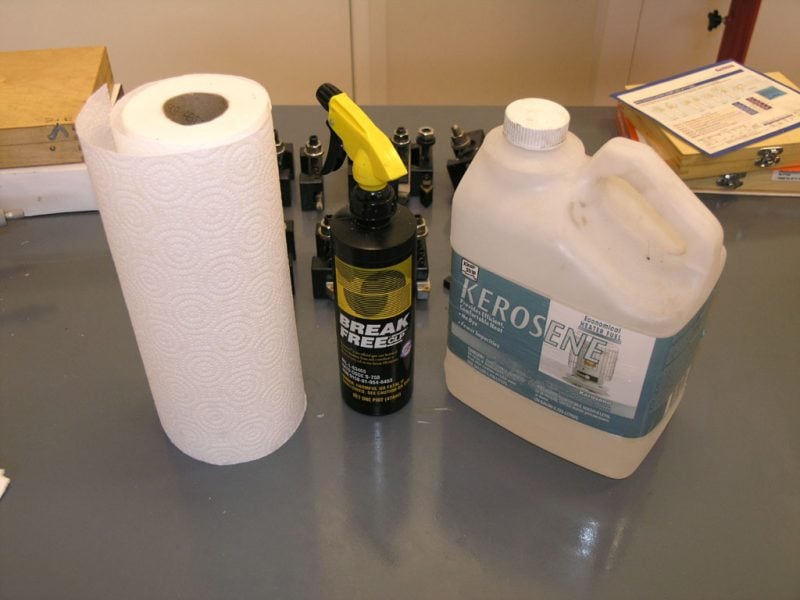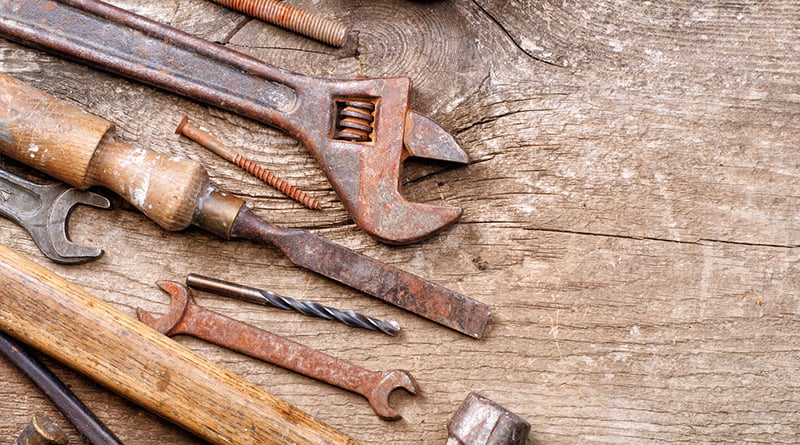It’s a real heartbreaker to pull out a tool you haven’t looked at in a while and discover it has rust. Nasty stuff. I live within sight of the ocean, so my shop is particularly susceptible. That’s made me a believer in rust protection. Once rust sets in, we can clean it, but better if you never give it a toehold.

My rust protection answer is to apply a rust-preventive oil, Break-Free, when I first get a tool into the shop. I also give a “booster shot” every so often on tools that are used a lot.
There are lots of products similar to Break-Free that are specifically formulated for rust protection. The firearms community is all over these products, and there are many reviews of them.
I chose Break-Free after reading one at The Gun Zone. They tested a variety of products under harsh conditions with a salt spray to accelerate the rust formation. That’s a much nastier test than your tools are likely to ever undergo, so a product that works well under those conditions can provide first-class rust protection for your tools.
Look into adopting one of these products for your own shop; it’s easy and makes a big difference.
Before doing this kind of research, many believe that WD-40 is the answer. But WD-40 is not particularly effective for rust protection. You’ll see that over and over again in the reviews of these products. The reason is that it is more of a water displacer, cleaner, and lubricant than a rust-preventive oil. It’s handy around the shop, but there are definitely better formulas for rust protection.
Another thing I like about Break-Free is it doesn’t leave much residue. I wipe it on with a paper towel and it leaves a shiny steel finish without feeling sticky or greasy to the touch.
Get Organized With a Tool Check-In Process
I like new toys as well as the next guy, so I try to take reasonable care of them. Towards that end, I’ve adopted a standardized “check-in” procedure for my shop. When a tool arrives, it is logged into an Excel spreadsheet. I have pages for tooling, consumables (cutters, abrasives, fluids, etc.), and stock (aluminum, steel, bearings, etc.). I don’t keep anything more than the description, date received, cost, any shipping cost, and the seller.
Another thing I started doing that’s useful: every six to 12 months I scan the list and highlight items I remember using. This gives me an idea of what things I bought that I have never used.

Once the items are logged into the spreadsheet, the next step is cleaning and rust protection. I clean any cosmolene (or other gummy residue) off with kerosene or brake cleaner, depending on how tough the residue is. BTW, WD-40 will also clean the stuff off since it is mostly kerosene with a little light oil.
That makes the tools shinier, but it also exposes them to potential rust. So, I immediately wipe them down with a rust-preventive oil. As mentioned, I like Break-Free, which is used by the U.S. military and others as a firearm rust-preventive oil. It passes the military’s über-tough PD-48 specification for rust protection.
Break-Free is available as an aerosol, but I prefer the pump bottle as shown. I’ve taken to using the pump style with WD-40, too — I still use WD-40 for lots of things, just not as a rust-preventive oil. You can order a bottle of Break-Free from Amazon for a little over $20.
I live on Monterey Bay, and there’s often a sea breeze. The breeze is nice, but it’s full of moisture and salt. Having a good rust-preventive oil like Break-Free helps me sleep better. I’ve never noticed any rust on my tools because of my proactive approach to rust protection.
On tools I use a lot, I may give them an extra wipedown before they go back in the tool box once a year or so. After a good wipedown with kerosene followed by some Break-Free rust-preventive oil, the tools are ready for use!
Last step in the tool check-in is to find the tool a home. It needs to live somewhere I’ll think to look for, and it needs a permanent home, not just a spot on a big pile of dissimilar things.
Try a check-in procedure at your shop. It’ll help you to be organized and it’ll help protect your tooling. In my shop, the tooling has rapidly become the lion’s share of my investment. In other words, I’ve spent more on tooling than machines. You’d be surprised at how easy this is to do, so why not invest in a little TLC for that tooling?
Full disclosure: CNCCookbook gets a small kickback from Amazon’s affiliate program if you use the link here to purchase Break-Free. If you don’t want that, just go to Amazon and search for Break-Free. Either way, you should try it — I’ve been using it for years, Break-Free works, and it’s good stuff.
This post originally appeared on the CNCCookbook blog.


